Adding a chatbot to your website can significantly improve your ability to service customers. That is a fact since chatbots are quickly becoming standard practice in different retail categories, and not having one could see you falling behind the competition. According to Hubspot, as of 2020, messaging apps had over 5 billion active monthly users. These numbers are completely understandable, considering that a chatbot is a direct and efficient way to resolve both complex and simple issues.
It’s a win-win situation, as both the customers and the brands will benefit from the interaction. The customers get immediate answers, without waiting in line for hours and the companies have better resolution ratings, which in turn increase conversions and retentions. If you are still not convinced, check out these chatbot retail use cases and best practices to learn how to incorporate one into your omnichannel customer service experience.
Table of Contents
- > What is a chatbot?
- > Examples of effective chatbot retail use cases
- > Chatbot use case #1: Asking for feedback
- > Chatbot use case #2: Handling customer complaints
- > Chatbot use case #3: Communicating personalized offers
- > Chatbot use case #4: Helping users solve technical problems
- > Chatbot use case #5: Replying to customer questions
- > Chatbot use case #6: Handling abandoned cart automations
- > Chatbot use case #7: Finding a nearby store
- > Chatbot use case #8: Tracking packages
- > Chatbot use case #9: Managing loyalty points
- > Chatbot use case #11: Improving customer service
- > Chatbot use case #12: Paying bills
- > Chatbot use case #13: Freeing up your customer service personnel
- > Chatbot use case #14: Improving the online shopping experience
- > Chatbot use case #15: Helping you grow your email list
- > Chatbot use case #16: Providing in-store support
- > Chatbot use case #17: Solidifying your branding
- > Chatbot use case #18: Signing up customers for free trials
- > Chatbot use case #19: Providing multilingual support
- > Chatbot use case #20: Sending push notifications
- > Chatbot use case #21: Providing data
- > Chatbots are everyone’s friend
What is a chatbot?
A chatbot refers to customer service software driven by artificial intelligence. The bot uses machine learning to simulate human conversation, allowing you to be available to customers 24/7 without adding extra staff members. You can program a chatbot to provide basic answers to frequently asked questions (FAQs) or get one that uses machine learning for more in-depth client interactions.
Examples of effective chatbot retail use cases
There are various ways you can use your chatbot for omnichannel customer engagement. Discover the advantages and streamline your customer service for optimal results, increasing your conversions.
Chatbot use case #1: Asking for feedback
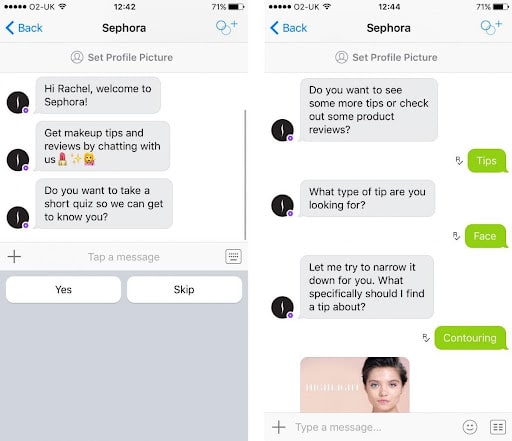
Instead of asking customers to fill out a satisfaction survey after every transaction, you can use a chatbot to collect feedback. Your chatbot can look through a customer’s interactions with your website and ask them to rate and review different products or services. If your customer gives something a lower rating, the chatbot retail app can follow up with a message asking for more information.
Retailer Sephora offers a live chat within its mobile and web app, but the store also joined the social network Kik, on which chatbots are used to connect with customers. With it, customers can take quizzes and talk to the bot to give product feedback.
Chatbot use case #2: Handling customer complaints
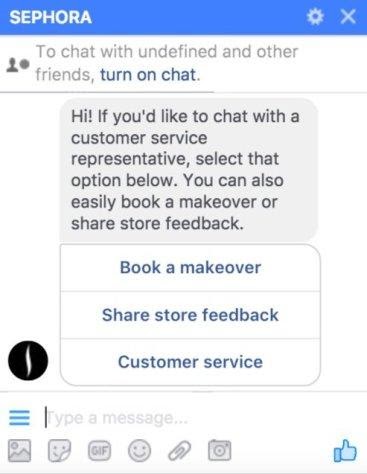
Some customer complaints will still have to be escalated to real people, but chatbots can deal with a lot of low-level client service issues or kick them up the chain if needed. An omnichannel chat that moves from the chatbot to customer service will help give context to escalations.
Customer service is one of the main chatbot retail use cases because this feature makes your service team available whenever the issue arises. Sephora also offers customers the option to resolve their issues through the app, or a customer can click a button to be connected to a live person in the same chat window.

Chatbot use case #3: Communicating personalized offers
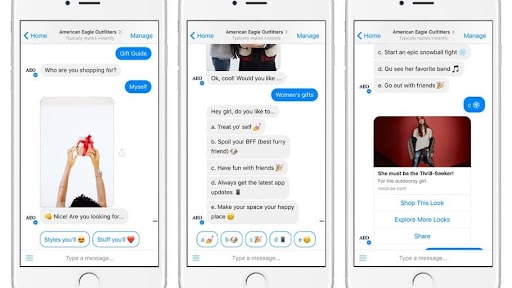
Customers love personalization, and a chatbot helps you whittle down their options. In this chatbot retail use case, your customer would answer a series of questions or a quiz when they enter your site. Based on their answers, the bot would direct them to merchandise or a section of your website that fits their needs. American Eagle Outfitters uses a quiz to create personal recommendations for people interacting with the chatbot.
Chatbot use case #4: Helping users solve technical problems
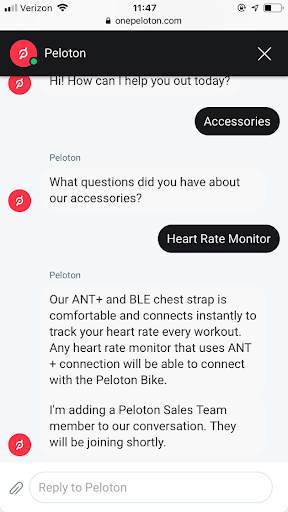
One drawback to buying merchandise online is that you lose access to product demonstrations. In-store, a sales associate can answer customer questions and help them learn to use your products. When shopping online or through an app, some of the directions might be lost in translation, which is where chatbots come in. Your chatbot can start the tech support conversation or connect each customer with members of the support team who can help them with their tech. Peloton offers a chatbot retail platform that lets customers ask various questions about all of its products. For technical issues like how to connect different devices, the bot can escalate the call.
Chatbot use case #5: Replying to customer questions
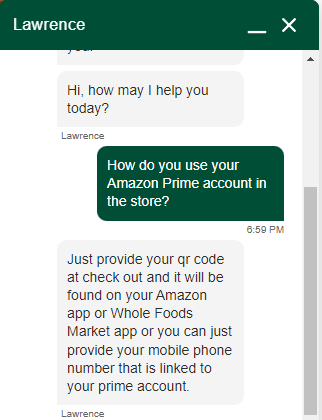
Using a chatbot lets you answer customer questions while they’re on the site. They don’t have to navigate to a separate page to see if their question is included in the FAQ. This type of real-time availability with a chatbot retail app frees up your live customer service team for more complicated customer requests without sacrificing customer service. Whole Foods uses chatbots in its live chat feature, letting customers ask questions in real-time. The bot offers a list of topics that let the bot know where to look for answers.
Chatbot use case #6: Handling abandoned cart automations
As an eCommerce site, you lose a lot of customers before they finish shopping with you. An estimated 80% of shopping carts were abandoned in March 2021. One of the more popular chatbot retail use cases is the automated abandoned cart message. This feature lets you remind shoppers to finish their transaction by popping up a message through the chatbot. You probably won’t recover all abandoned carts, but you can recoup some customers.
Shopify estimates that abandoned cart emails have an open rate of 45% and they can recover about 11% of sales. Your chatbot retail app can send out these messages more quickly than email, giving you the chance to recoup more potential sales.
Chatbot use case #7: Finding a nearby store
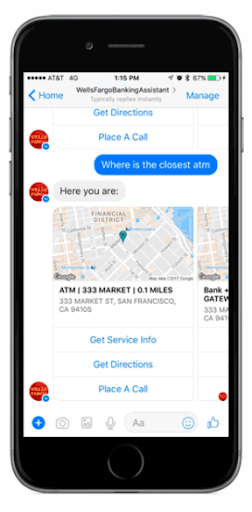
For service-oriented retail businesses, chatbots are a great way to help your clients find a branch near them. A retail banking chatbot can offer nearby suggestions to current customers looking for somewhere to go get cash or deposit a check in person.
With permission, chatbots can access your customers’ location, making it easy for the bot to find a store nearby. Wells Fargo’s banking assistant uses customers’ phone locations to find them a nearby branch. When prompted, the chatbot sends out a location with a map and the option to call the shop or get directions.
Chatbot use case #8: Tracking packages
Online shopping doesn’t offer the same instant gratification as in-person shopping, and customers can get impatient. Chatbot retail use cases aren’t limited to the initial transaction. You can also use them to keep customers in the loop about their order status.
You can program your chatbot to send tracking information to customers when they ask for it or send them an email that directs them to the shipper’s chatbot. Most logistics companies offer the ability to chat with a bot on the tracking screen, so customers can ask questions if their package is delayed.
Chatbot use case #9: Managing loyalty points
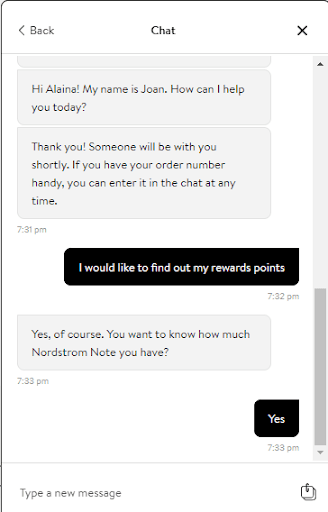
If you offer a loyalty program, your chatbot retail app can help customers manage their accounts. Instead of having to keep a card on file, they can chat with your bot to check their points balance, access rewards, and find other information. Your chatbot can also help loyalty members access their perks.
If your most loyal customers get access to personal stylists, your chatbot can help them book their appointments. During the booking process, the bot can ask questions and guide the conversation so the stylist has an idea of what kinds of looks to pull before your client ever comes into the store. Nordstrom lets Nordy Club rewards members check their account balances and find out information about their rewards by talking to chatbots.
Chatbot use case #10: Notifying customers of promotions
Although chatbots are being widely used to enhance customer service and client relationship management, they are also great for marketing. Some chatbot retail use cases involve promoting certain items and upselling your customers.
Chatbots for retail and eCommerce are evolving as they become advanced enough to tackle marketing and customer service. Use your chatbot to drive retail sales by notifying your customers of current promotions and sales within the store.
Hello Fresh offers a discount to customers who ask via the chatbot. The bot also takes the opportunity to promote other available discounts as a chance to upsell the customer.
Chatbot use case #11: Improving customer service
A third of customers in the U.S. plan on online ordering and in-store pickup following the pandemic. Chatbots are a key component of this omnichannel customer engagement. Your chatbot can help customers find products, ask questions about in-store inventory, schedule pickup, and notify team personnel when they have arrived to pick up their order.
Chatbots make the online and in-person customer service experience seamless. Your chatbot can contact customers throughout their order process, notifying them if products aren’t available and offering substitutions. Your customers can manage their orders in real-time without disrupting in-store operations.
An example of chatbot use cases with seamless customer service is the Kroger grocery chain. Kroger’s app makes it easy to order for pickup. If substitutions are needed, the chatbot texts clients to accept or reject the new items.
Chatbot use case #12: Paying bills
Using a chatbot in retail to pay bills might not be the first image that comes to mind. But if your company offers a credit card or if you’re a financial institution, a chatbot for retail can also help customers pay their bills the way they would in the store.
Other retail chatbot examples in which customers can pay bills include cell phones and other services. Your customers can connect with the bot to find out how much they owe and use it to process a secure payment. The bot would then send a receipt to their phone.
Chatbot use case #13: Freeing up your customer service personnel
Perhaps the best chatbot use cases for retail involve freeing up your actual customer service reps. Since your retail chatbot can handle simple customer service issues, your human representatives are free to work smarter. They don’t have to spend their time answering simple customer questions. Instead, they can focus on complex customer issues.
Your chatbot for retail can handle more customers in a day because you can use more than one. Since these simple requests are easier to turn over, more customers leave your store feeling like their needs were met.
Chatbot use case #14: Improving the online shopping experience
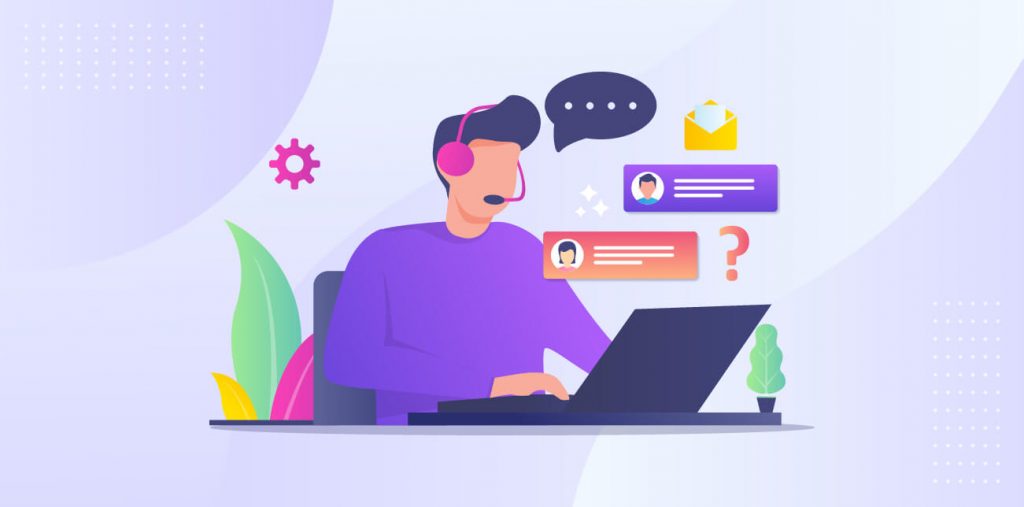
Chatbot retail use cases also include transactions where the bot handles a whole transaction. Since chatbots in the retail industry have a conversation with online shoppers, the experience is more comparable to what they would expect in-store.
Your chatbot retail app lets customers have a dialogue with a customer service agent instead of navigating multiple web pages and searching high and low for frequently asked questions or merchandise. Another interesting fact is that chatbot retail sales are steadily increasing and are projected to grow to over $100 billion in the next year.
Chatbot use case #15: Helping you grow your email list
There are plenty of ways to grow your retail email list, and chatbots in the retail industry are allowing more businesses to grow. While simply chatting with the bot might not encourage people to join your email list, the bot can increase their chances of signing up.
You can train your chatbot for retail to ask each customer if they want to join the email list at the end of every transaction. Or you can have the chatbot promote incentives for joining, like exclusive discounts.
Chatbot use case #16: Providing in-store support
Hybrid chatbot retail stores in which your customer service team is assisted by chatbots are becoming popular. You could add kiosks to information desks where people can use tablets to ask chatbots simple questions while your service reps are busy.
You can also give employees access to the chatbots so they can find answers and more easily locate inventory. If a customer wants to compare prices or look for the inventory in another store location, your in-store team can quickly access this information with the chatbot.
Chatbot use case #17: Solidifying your branding
One of the best things about a chatbot in retail is that you can program it to match your brand voice. Even though you can train your customer service representatives to use your brand tone and voice, their interactions with customers will vary, because they are human.
You can program your chatbot to match your brand tone, making each customer interaction consistent from your website to social media to your chatbot. The previous retail chatbot examples from American Eagle and Sephora show how your chatbot becomes an extension of your brand, personifying your image with each customer.
Chatbot use case #18: Signing up customers for free trials
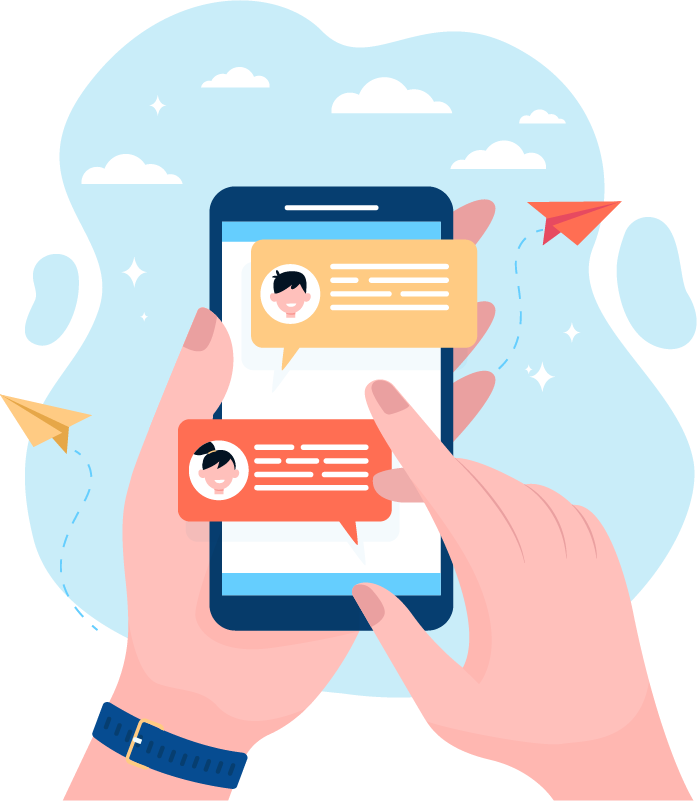
Program your chatbot retail app to automatically offer free trials to customers who ask for more information about your product or service. The best chatbot for retail will offer multiple features that improve the customer journey and will be able to sign customers up for product demonstrations and free trials without having to contact an in-person representative.
Chatbot use case #19: Providing multilingual support
Your retail business may operate internationally or in a large city where people speak multiple languages. Your chatbot gives you the chance to offer support in multiple languages without having to search for customer services representatives in your area.
While you will likely be able to find bilingual service representatives who speak common languages like Spanish or Mandarin, you might not have employees who speak every language. Find a chatbot retail platform that lets you program answers in multiple languages.
Chatbot use case #20: Sending push notifications
Whether you’re offering online ordering and in-store pickup, tracking packages, or following up on abandoned carts, your chatbot can be used for push notifications. Program your chatbot to notify customers at different points of their journey.
You can send automated push notifications to make customers aware of new order statuses, including shipping notifications with their tracking number. Sending an abandoned cart push notification makes it more noticeable and might improve your chances of recovering the sale.
Chatbot use case #21: Providing data
While they ensure a seamless customer journey for customers, chatbots can also provide you with valuable information. If your chatbot platform offers analytics, use them to look for keywords and other data to determine how customers feel about your brand.
Sophisticated chatbot retail platforms use machine learning to become smarter with each transaction. Over time, they learn to identify keywords and craft better responses. You can “train” your chatbot to learn when a customer needs to be escalated to a real person without the customer having to ask multiple times. You can also use your analytics to figure out how people want to improve your products.
Chatbots are everyone’s friend
These retail chatbot use cases demonstrate multiple potential ways in which you can use them and improve customer experience. Applications such as these, take the customer service burden off your human service reps by handling frequently asked questions and simple requests.
A chatbot in retail industry websites and mobile apps will let your service team be available 24/7 without having to hire additional staff. Your customers are more likely to be satisfied because they will have an immediate answer to their questions in real-time without having to wait for the phone lines to open.
Chatbots can notify your clients of upcoming promotions, and they can upsell your customers by showing them complementary products. They can also direct your customers to personalized recommendations. Your customers can use this tool to manage their loyalty points, making it easier for them to shop more often and earn more points.
Now that you know how a chatbot can work for your retail company, book a free, 30-minute demo with ContactPigeon’s skilled representatives and learn how you can deploy an omnichannel chat for your business. Consider adding this valuable tool to your website and stay ahead of your competition.

Let’s Help You Scale Up




![Benchmarking Growth Strategies of Top Fashion Retailers [Study]](https://blog.contactpigeon.com/wp-content/uploads/2025/11/top-fashion-retailers.jpg)